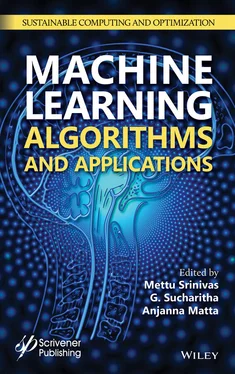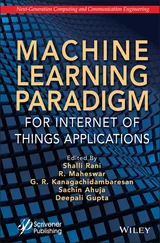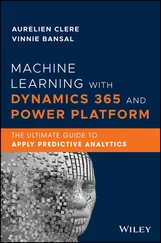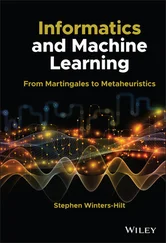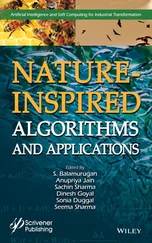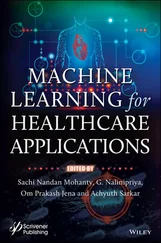Machine Learning Algorithms and Applications
Здесь есть возможность читать онлайн «Machine Learning Algorithms and Applications» — ознакомительный отрывок электронной книги совершенно бесплатно, а после прочтения отрывка купить полную версию. В некоторых случаях можно слушать аудио, скачать через торрент в формате fb2 и присутствует краткое содержание. Жанр: unrecognised, на английском языке. Описание произведения, (предисловие) а так же отзывы посетителей доступны на портале библиотеки ЛибКат.
- Название:Machine Learning Algorithms and Applications
- Автор:
- Жанр:
- Год:неизвестен
- ISBN:нет данных
- Рейтинг книги:4 / 5. Голосов: 1
-
Избранное:Добавить в избранное
- Отзывы:
-
Ваша оценка:
- 80
- 1
- 2
- 3
- 4
- 5
Machine Learning Algorithms and Applications: краткое содержание, описание и аннотация
Предлагаем к чтению аннотацию, описание, краткое содержание или предисловие (зависит от того, что написал сам автор книги «Machine Learning Algorithms and Applications»). Если вы не нашли необходимую информацию о книге — напишите в комментариях, мы постараемся отыскать её.
Machine Learning Algorithms and Applications — читать онлайн ознакомительный отрывок
Ниже представлен текст книги, разбитый по страницам. Система сохранения места последней прочитанной страницы, позволяет с удобством читать онлайн бесплатно книгу «Machine Learning Algorithms and Applications», без необходимости каждый раз заново искать на чём Вы остановились. Поставьте закладку, и сможете в любой момент перейти на страницу, на которой закончили чтение.
Интервал:
Закладка:
2. Li, H., Fan, H., Mao, F., A visualization approach to air pollution data exploration—a case study of air quality index (PM2. 5) in Beijing, China. Atmosphere , 7, 3, 35, 2016.
3. Lu, W., Ai, T., Zhang, X., He, Y., An interactive web mapping visualization of urban air quality monitoring data of China. Atmosphere , 8, 8, 148, 2017.
4. Kumar, A., Sinha, R., Bhattacherjee, V., Verma, D. S., & Singh, S., Modeling using K-means clustering algorithm. 1st International Conference on Recent Advances in Information Technology (RAIT) , vol. 1, 554–558, IEEE, 2012.
5. Fan, J., Li, Q., Hou, J., Feng, X., Karimian, H., Lin, S., A spatiotemporal prediction framework for air pollution based on deep RNN. ISPRS Annals of the Photogrammetry, Remote Sensing and Spatial Information Sciences , vol. 4, p. 15, 2017.
6. Pereira, R.L., Sousa, P.C., Barata, R., Oliveira, A., Monsieur, G., CitySDK Tourism API-building value around open data. J. Internet Serv. Appl ., 6, 1, 1–13, 2015.
7. Adeleke, J.A., Moodley, D., Rens, G., Adewumi, A.O., Integrating statistical machine learning in a semantic sensor web for proactive monitoring and control. Sensors , 17, 4, 807, 2017.
8. Kim, S.H., Choi, J.W., Han, G.T., Air pollution data visualization method based on google earth and KML for Seoul air quality monitoring in realtime. Int. J. Software Eng. Its Appl ., 10, 10, 117–128, 2016.
9. Sharma, S., Zhang, M., Gao, J., Zhang, H., Kota, S.H., Effect of restricted emissions during COVID-19 on air quality in India. Sci. Total Environ ., 728, 138878, 2020.
10. Mahato, S., Pal, S., Ghosh, K.G., Effect of lockdown amid COVID-19 pandemic on air quality of the megacity Delhi, India. Sci. Total Environ ., 730, 139086, 2020.
11. Lloyd, S., Least squares quantization in PCM. IEEE Trans. Inf. Theory , 28, 2, 129–137, 1982.
12. Hochreiter, S. and Schmidhuber, J., Long short-term memory. Neural Comput ., 9, 8, 1735–1780, 1997.
13. Hasenkopf, C. A., Flasher, J. C., Veerman, O., & DeWitt, H. L., OpenAQ: A Platform to Aggregate and Freely Share Global Air Quality Data. AGU Fall Meeting Abstracts , 2015, A31D-0097, 2015.
14. Pedregosa, F., Varoquaux, G., Gramfort, A., Michel, V., Thirion, B., Grisel, O., Vanderplas, J., Scikit-learn: Machine learning in Python. J. Mach. Learn. Res ., 12, 2825–2830, 2011.
15. Manaswi, N. K., Understanding and working with Keras, Deep Learning with Applications Using Python , vol. 1, pp. 31–43, Springer, 2018.
1 *Corresponding author: priyankjn62@gmail.com
2 †Corresponding author: gagandeep.kaur@jiit.ac.in
2
Automatic Counting and Classification of Silkworm Eggs Using Deep Learning
Shreedhar Rangappa1*, Ajay A.1 and G. S. Rajanna2
1Intelligent Vision Technology, Bengaluru, India
2Maharani Cluster University, Sheshadri Road, Bengaluru, India
Abstract
The method of using convolutional neural networks to identify and quantify the silkworm eggs that are laid on a sheet of paper by female silk moth. The method is also capable of segmenting individual egg and classifying them into hatched egg class and unhatched egg class, thus outperforming image processing techniques used earlier. Fewer limitations of the techniques employed earlier are described and attempt to increase accuracy using uniform illumination of a digital scanner is illustrated. The use of a standard key marker that helps to transform any silkworm egg sheet into a standard image, which can be used as input to a trained convolution neural network model to get predictions, is discussed briefly. The deep learning model is trained on silkworm datasets of over 100K images for each category. The experimental results on test image sets show that our approach yields an accuracy of above 97% coupled with high repeatability.
Keywords:Deep learning, convolution neural network, datasets, accuracy, silkworms, fecundity, hatching percentage
2.1 Introduction
In the last decade, machine learning has gained the popularity that no sequential programming approach has reached in a century in various fields of engineering. Deep learning/convolution neural network (CNN) is a part of a machine learning approach that solves a given problem without explicitly providing the features to be considered to generate useful results. These advanced techniques are predominantly deployed in the engineering field. However, disciplines such as medical imaging [1], microbiology [2], and finance [3] are vastly adopting machine learning to achieve superior results.
Further, some areas of science still use the conventional approach of solving the problem, and sericulture is one among them. The sericulture industry involves the art and science of host plant cultivation as well as silkworm rearing to produce natural silk products. Silk is the queen of textiles and globally India is the second-largest producer of four different types of silk. Thus, sericulture serves as the base for economic, social, scientific, political, and intellectual advancements [4]. The fecundity (number of eggs laid by fertilized female silk moth), hatching percentage (silkworm birth rate), survival percentage (disease and environment tolerant), and silk productivity are a few economic traits (parameters) on which entire silk industry thrives. Manual counting of eggs is in vogue to quantify fecundity and hatching percentage parameters. Many automatic methods (image processing and new hardware design) have been attempted with lower accuracy [5]. A new approach of automatic counting and classifying eggs is described in this paper to quantify fecundity and hatching percentage accurately which provides required rearing information to harvest successful silk cocoon crops.
The chapter describes a few conventional approaches and their drawbacks and, further, introduce the CNN approach adopted in this paper and to explain the specifications of each model trained to surpass the results provided by other image processing techniques.
2.2 Conventional Silkworm Egg Detection Approaches
Manual counting of silkworm egg is in practice in countries like India, China, Thailand, and other Asian countries [6]. The silkworm eggs are small-sized [5], approximately 2 to 3 mm in diameter, densely populated in small clusters. Hence, the manual counting process will be tediously associated with prolonged time and is susceptible to human error. The inconsistency in determining the fecundity and hatching percentage impacts the overall cocoon crop performance and Silk productivity.
Many techniques have been implemented to measure the quantity of egg laid, such as designing hardware [6, 7], and using image processing techniques. The primary focus in previously published papers was to segment the silkworm egg from the background using different image processing techniques such as low contrast image setting [8], contrast enhancement followed by image morphological operations [7], image patch centroid analysis [6], image channel conversion from RGB to HSV to identify the region of interest (ROI) [9], using Gaussian mixture model [10], and using Hough transforms (blob analysis) [11, 12]. The accuracy achieved in these techniques completely depends on the consistency of the experimental conditions such as the color of the sheet on which the silkworm eggs were laid, the size of the eggs, and uniform illumination while capturing a digital image of eggs. By altering any one of these parameters, the results vary drastically, and hence designing an image processing algorithm for every possible scenario becomes laborious. Also, the method used in these techniques to capture digital data of the eggs was to use digital cameras, operated manually without any preset illumination parameter and hence resulting in poor accuracy.
Читать дальшеИнтервал:
Закладка:
Похожие книги на «Machine Learning Algorithms and Applications»
Представляем Вашему вниманию похожие книги на «Machine Learning Algorithms and Applications» списком для выбора. Мы отобрали схожую по названию и смыслу литературу в надежде предоставить читателям больше вариантов отыскать новые, интересные, ещё непрочитанные произведения.
Обсуждение, отзывы о книге «Machine Learning Algorithms and Applications» и просто собственные мнения читателей. Оставьте ваши комментарии, напишите, что Вы думаете о произведении, его смысле или главных героях. Укажите что конкретно понравилось, а что нет, и почему Вы так считаете.
